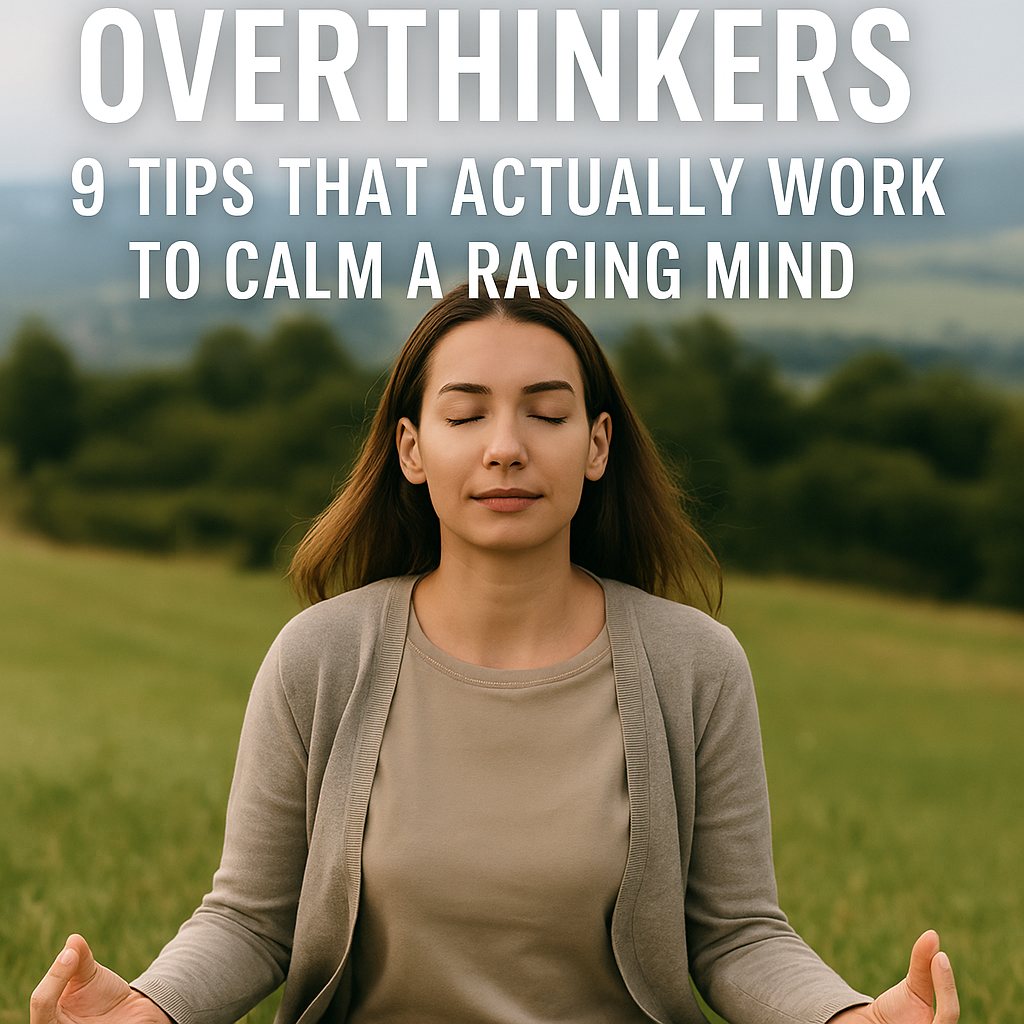Introduction: Why Overthinkers Struggle With Meditation
If you’ve ever felt like your mind just won’t stop racing, even during meditation, you’re not alone. Overthinking is very common. And it makes traditional meditation feel frustrating or even impossible. Thankfully, there’s good news: meditation for overthinkers isn’t about emptying your mind—it’s about learning how to work with it.
You sit down to meditate, hoping for peace—but instead, your brain explodes with thoughts. Sound familiar?
According to experts like Dr. Judson Brewer, mindfulness for overthinkers helps calm the brain, reduce anxiety, and sharpen focus. You don’t need hours of silence or perfect posture. Instead, you need simple tools and a gentle approach.
In this article, you’ll learn 9 easy, proven meditation techniques for overthinking. Whether you’re just starting or have struggled before, these beginner meditation tips can help you feel calmer and more focused—without trying to force your thoughts away.
1. Understand Why Meditation Feels Hard When You Overthink
Overthinking is your brain’s way of trying to protect you. It keeps scanning for problems to solve. However, during meditation, that habit turns inward—and your thoughts start spinning.
Instead of fighting your thoughts, try this: watch them like clouds floating by. The more you observe without reacting, the more your brain relaxes. This is how awareness begins to quiet the noise.
2. Best Meditation Style for Overthinkers
Sitting still and staying silent can be hard. Luckily, there are other ways to meditate.
You can try:
- Moving slowly while walking or stretching
- Repeating a word or sound
- Listening to a calming voice or story
- Focusing on how your body feels as you breathe
In short, meditation doesn’t have to look one way. Try different methods to find what fits you best.
3. Use Guided Meditation for Overthinking (Instead of Silence)
For overthinkers, silence can make the mind louder. But there’s a solution: let someone guide you.
Use apps like:
- Insight Timer
- Balance
- UCLA Mindful or Headspace
A soft, steady voice gives your mind something to follow. As a result, it’s easier to stay focused and relaxed.
4. Breath-Based Anchoring Techniques
Your breath is always with you. It’s a simple, calming tool.
Try this:
- Inhale for 4 seconds, exhale for 4
- Or use box breathing: inhale-hold-exhale-hold (4 counts each)
Even one minute of focused breathing can help slow down racing thoughts and ease anxiety.
5. Focus on Repetition (Mantras, Dhikr, or Counting)
Repeating something gives your mind a safe rhythm to follow.
Examples include:
- Saying “breathe,” “calm,” or “here” with each breath
- Repeating a word like “peace” or a short phrase like “I am okay”
- Counting from 1 to 10, then starting again
Repetition makes it easier to stay grounded.
6. Add Gentle Movement to Your Meditation Practice
Sometimes your body needs to move to help your mind settle.
You can try:
- Walking slowly and focusing on your steps
- Doing gentle yoga or stretching with deep breathing
- Rocking, tapping, or swaying slowly
In fact, moving with purpose can help you stay present and aware.
7. Keep Sessions Short and Expect Distraction
Don’t aim for long sessions right away. It’s okay to start small.
Start with:
- Just 2 or 3 minutes a day
- A quiet space and a timer
- Kindness to yourself when your mind wanders
Remember, progress comes with practice. Even short moments matter.
8. Try Writing Meditation (AKA Thought Dumping Before Sitting)
Sometimes your mind needs to let things out before it can be quiet.
Here’s what to do:
- Write everything on your mind for 3–5 minutes
- Don’t worry about spelling or structure—just write
- Then do a short breathing meditation
This helps clear mental clutter and makes sitting feel easier.
9. Pair Meditation with Daily Routines
Link meditation to something you already do each day.
For example:
- Breathe deeply while brushing your teeth
- Stretch mindfully before bed
- Do a one-minute breath before eating
By connecting it to your habits, meditation becomes part of your normal routine.
Bonus: What NOT to Do as an Overthinking Meditator
To avoid frustration, keep these in mind:
- Don’t expect your mind to go completely quiet
- You should not judge yourself for being distracted
- Try not to keep switching techniques too fast
✅ Instead: Be patient. Be gentle. Keep showing up.
Conclusion: You Can Meditate—Even If You Overthink Everything
Meditation for overthinkers isn’t about forcing your mind to be quiet. It’s about noticing your thoughts and learning to let them pass.
Each tip in this article—from breathing and repetition to writing and movement—can help calm your thoughts and focus your mind.
Start small. Try just one tip today. Even a few mindful moments can lead to more peace.
You don’t need a perfect mind to start meditating. You just need a simple moment—and a little kindness.
Read more about: 10 Reasons Why Good Sleep Is Important
The Ultimate Step-by-Step Guide to Open Your Heart
30 Mindfulness Activities
Mayo Clinic – Meditation: A simple, fast way to reduce stress
Harvard Health – Mindfulness meditation may ease anxiety


One thought on “Meditation for Overthinkers: 9 Tips That Actually Work to Calm a Racing Mind”